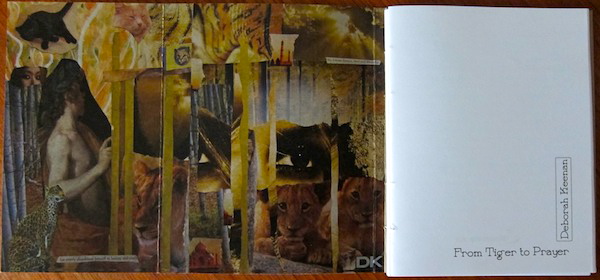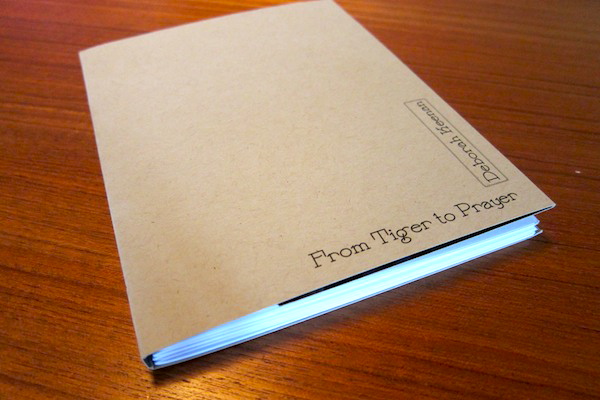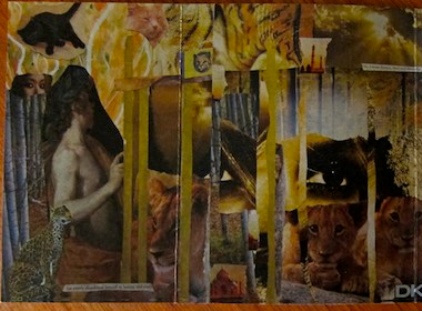Deborah Keenan: Prompts, Poems and Pictures
Both author and publisher simply call FROM TIGER TO PRAYER a writer's workbook, a volume small enough to fit in your palm, with 79 writing prompts by poet and teacher Deborah Keenan. We say, in that case, you'd have to call it a workbook on steroids






From Tiger to Prayer is, at first glance, a mystery. A collaboration between Twin Cities poet and teacher, Deborah Keenan, and St. Paul-based broadcraft press, the wheat-colored cover on the small volume gives away only the title and author. The initials DK and bcp are all that adorn its flexible spine. So, what is this thin, soft-covered book that fits in the palm of my hand?
Both the author and broadcraft’s poet-book artists Meghan Maloney-Vinz and Kate Shuknecht call From Tiger to Prayer simply a writer’s workbook that contains 79 writing prompts by Deborah Keenan. But if From Tiger to Prayer is a workbook, this plain-on-the-outside, small volume is, it must be said, a workbook on steroids. Just open the book’s cover and you’ll begin to see what I mean. The inside cover, which folds out, contains a full-color collage of delicate, dreamlike images and text created by Keenan, who is also a visual artist. The first edition of From Tiger to Prayer offers four different collage choices (pictured in the slideshow above), chosen from Keenan’s countless creations. The binding of this first edition was also hand-stitched, a labor-of-love process that took about three months for Maloney-Vinz and Shuknecht to complete. The work was literally painstaking: 300 books later, their fingers were covered with bookbinding needle scabs.
At the book launch in August, Keenan’s former and current students and members of the Twin Cities literary community filled Hamline’s Creative Writing programs office. Three independent bookstores carried the book — and it sold out fast. (According to Keenan’s blog, a second printing will come in late November, after which copies will be available at Common Good Books and Micawber’s.) But what inspired all this local support for a hand-stitched book of writing prompts? Simply put, it’s Deborah Keenan. For over 40 years, Keenan has been teaching poetry, creative writing, and literature in Minnesota — as a writer-in-the-schools, at the Loft, at various Twin Cities colleges and universities, and as part of the core faculty of Hamline University’s Creative Writing programs. In the midst of all this, Keenan also published eight books of poetry, collaborated with poet Jim Moore on a poetry collection, co-edited an anthology with poet Roseann Lloyd, served as a managing editor at Milkweed Editions for four years, co-founded the Laurel Poetry Collective, contributed poems to numerous journals and anthologies, and won prestigious grants and awards. An impressive literary resume, yes, but even that list doesn’t begin to capture the full effect that Keenan has had on the hundreds of writers and literature lovers who have encountered her in the classroom and on the page. (Full disclosure: I graduated from Hamline’s MFA in Writing program in 2006, and I was one of her students.)
“I didn’t have a thousand other talents,” Keenan demurs when her accomplishments are mentioned. “I was a good writer and had a lot of determination to get better.” Eight books of poetry later, she is still passionately writing, and teaching. “I feel really lucky. I love teaching.” When she talks about her interactions with students, the hawk-like gaze of her gray-blue eyes softens a bit: “I get to say: you’ve got to read this poem; you’ve got to read this line. Here’s all this stuff that I’ve read and find inspiring. It might keep you going.”
Though Keenan is low-key when describing her work as an artist and teacher, the young women of broadcraft press are unabashedly full of praise for their former teacher. Kate Shuknecht, who graduated three years ago from Hamline University’s MFA in Writing program vividly remembers the first time she heard Keenan speak. “Her voice was magical, compelling, serious without being harsh. She talked about art as such an imperative part of her existence that you wanted it, too.” Keenan’s own poetry also inspired her. “She’s the most quietly fearless poet I know. I love how she continuously honors what’s true to her.”
Throughout Shuknecht’s graduate school experience, she says Keenan wrote countless prompts and writers’ quotes on the blackboard, distributed “stacks and stacks” of handouts and provided “the widest variety of inspiration, making connections between things that you wouldn’t think of otherwise. She found a way to communicate with everyone in the way that they needed.” And Keenan insisted that all her students deserved to be artists. “She would say, ‘Of course you should be working on this poem, of course this poem is important.’ It was a whole new level of permission,” Shuknecht recounts, her eyes brimming with tears.
You see the coyote standing in the alley. What can you do with your poem to make that coyote move? You stop the river. Then you let it flow, or rage. You make dawn turn into daybreak.
Meghan Maloney-Vinz came to Hamline’s MFA program after eight years of teaching literature to high school students. She could immediately sense that Keenan was “a phenomenal teacher,” but the class that really “busted the doors open” for her was Keenan’s Inspired by the Visual, an interdisciplinary examination of poetry’s relationship with visual art. On the first day of this class, Maloney-Vinz sat, enveloped by prints of paintings and photos that Keenan had taped to every wall of the classroom, working to create “a living collage.” Maloney-Vinz, both a fledgling poet and artist, says the cross-pollination process was a total delight. By assigning “visual pieces” to complement the writing, Keenan’s class explicitly invited her to blend her literary and visual impulses: “It was like crack for me.” And after this class, Maloney-Vinz says she delved deeply into book arts at Hamline and co-designed the pilot issue of Hamline’s student literary journal, Rock, Paper, Scissors. Shuknecht joined the journal’s design committee the next year, prompted both by Keenan’s multi-disciplinary approach to literature and Maloney-Vinz’s work in the publication.
Keenan’s push to integrate visual and literary art continued to motivate the poet-book designers after graduation. They co-founded broadcraft press in 2010 with two other Hamline alumnae (who have since left the press due to other commitments) in order to “create meaningful and lasting artifacts for and with writers and literary artists.” By 2012, broadcraft had so successfully fulfilled their mission that one of their books, Buddha, Proof—a collaboration with writer Su Smallen—was nominated for a Minnesota Book Award.
In summer 2012, the broadcraft women sat down with Keenan to begin their next collaboration. But unlike their previous projects — book ideas pitched to them by other writers — Keenan, by far the most widely published author on their list, did not have a book in mind. “She just knew she wanted to work with us,” says Shuknecht, and that she wanted to work as part of the creative team—a testament to Keenan’s generosity and collaborative spirit.
The idea for From Tiger to Prayer came from Maloney-Vinz, who showed the group a personal project she had made after graduating from Hamline: a little handmade journal, inside of which she had handwritten “Deborah quotes” taken from her poetry class notebooks. While raising her young daughter, she kept the book in her purse as a “touchstone, a reminder to always be aware of myself as a writer, even at the playground or at Choo-Choo Bob’s.”
The press loved the idea of creating a book of Deborah Keenan writing prompts. Keenan was honored and delighted: “I love small books that can ride along in backpacks, inside purses, or pockets.” When her children were young, Keenan says, she often sat in her car with a small notebook and wrote, while waiting for them to finish basketball practice, sports events, or dances. She still carries little journals with her to jot down ideas and do artwork.
For me, as a writer, for all its handcrafted beauty and portability From Tiger to Prayer’s greatest asset is its text. For 79 pages you’ll find Keenan’s prompts floating in the middle of white space, one prompt per page. Each is imbued with that sense of permission to be an artist so important to Shuknecht and Maloney-Vinz when they were MFA students. And each prompt is written in the insistent, humane, image-rich, informal yet lyrical voice that is singular to Keenan. Because of that, From Tiger to Prayer reads like a book of poems.
Here is a sample:
What never lies? Write that poem, and nine more to go with it.
Think of three things on display in the private museum of your mind. (A lion, a suburban neighborhood, a laundry basket. OR: a feast, a knife, a breakdown.) How do you write poems from this private museum?
Think about an image being activated. (You see the coyote standing in the alley. What can you do with your poem to make that coyote move? You stop the river. Then you let it flow, or rage. You make dawn turn into daybreak.) What movements, shifts in time and space, what transformations are you actually interested in?
Use your absolutes. All, none, always, never. Understand your relationship to power through use of absolute. Understand what power, or wanting power, or rejecting power has to do with your poems.
How are you an orphan of something not human? Sunset’s orphan? The moon’s orphan?
Write the poem called “Proof.”
From Tiger to Prayer is a writer’s workbook, yes, but also lovely example of book art, an unofficial poetry collection and a fine tribute to a local literary treasure. And Keenan’s collaborative temperament continues to ignite her creative process: She is currently partnering with painter Susan Solomon on a collection of poems and paintings, commissioned by Redbird Chapbooks, another small press founded by Hamline MFA graduates who have been inspired by Deborah Keenan’s cross-disciplinary mind. This chapbook will be released in late fall of this year.
Related links and information: On December 9 at Maeve’s Café (300 13th Ave NE, Minneapolis) from 7 to 9 p.m., there will be an open mic-style reading where Deborah’s fans, friends, and students can read poems that were inspired by From Tiger to Prayer. The event is coordinated by poet Gretchen Marquette. For more about and by Deborah Keenan, visit her website: http://deborahkeenan.com/. For more on the new book, From Tiger to Prayer: http://broadcraftpress.com/books/.
About the author: Alison Morse’s poems and stories have been published in Rhino, Opium Magazine, Natural Bridge, Water~Stone Review, Northeast Review, and mnartists.org, among other journals and anthologies. In 2012, her work won a Tiferet Fiction Award. From 2011-13, she was a writer for the Women Peacemakers Program at the Joan Kroc Institute for Peace and Justice in San Diego. She also runs TalkingImageConnection (TIC), a reading series where writers respond to visual art in Twin Cities galleries.